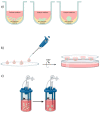Applications and Advances of Multicellular Tumor Spheroids: Challenges in Their Development and Analysis
- PMID: 37108113
- PMCID: PMC10138394
- DOI: 10.3390/ijms24086949
Applications and Advances of Multicellular Tumor Spheroids: Challenges in Their Development and Analysis
Abstract
Biomedical research requires both in vitro and in vivo studies in order to explore disease processes or drug interactions. Foundational investigations have been performed at the cellular level using two-dimensional cultures as the gold-standard method since the early 20th century. However, three-dimensional (3D) cultures have emerged as a new tool for tissue modeling over the last few years, bridging the gap between in vitro and animal model studies. Cancer has been a worldwide challenge for the biomedical community due to its high morbidity and mortality rates. Various methods have been developed to produce multicellular tumor spheroids (MCTSs), including scaffold-free and scaffold-based structures, which usually depend on the demands of the cells used and the related biological question. MCTSs are increasingly utilized in studies involving cancer cell metabolism and cell cycle defects. These studies produce massive amounts of data, which demand elaborate and complex tools for thorough analysis. In this review, we discuss the advantages and disadvantages of several up-to-date methods used to construct MCTSs. In addition, we also present advanced methods for analyzing MCTS features. As MCTSs more closely mimic the in vivo tumor environment, compared to 2D monolayers, they can evolve to be an appealing model for in vitro tumor biology studies.
Keywords: 3D cell cultures; SPIM; cancer; microscopy; multicellular tumor spheroids (MCTS).
Conflict of interest statement
The authors declare no conflict of interest.
Figures





Similar articles
-
Direct transfer of multicellular tumor spheroids grown in agarose microarrays for high-throughput mass spectrometry imaging analysis.Anal Bioanal Chem. 2025 Jun;417(14):3021-3031. doi: 10.1007/s00216-025-05843-x. Epub 2025 Mar 29. Anal Bioanal Chem. 2025. PMID: 40156633 Free PMC article.
-
Multicellular tumor spheroids: A convenient in vitro model for translational cancer research.Life Sci. 2024 Dec 1;358:123184. doi: 10.1016/j.lfs.2024.123184. Epub 2024 Oct 28. Life Sci. 2024. PMID: 39490437 Review.
-
High-Content Screening Comparison of Cancer Drug Accumulation and Distribution in Two-Dimensional and Three-Dimensional Culture Models of Head and Neck Cancer.Assay Drug Dev Technol. 2018 Jan;16(1):27-50. doi: 10.1089/adt.2017.812. Epub 2017 Dec 7. Assay Drug Dev Technol. 2018. PMID: 29215913 Free PMC article.
-
High Content Screening Characterization of Head and Neck Squamous Cell Carcinoma Multicellular Tumor Spheroid Cultures Generated in 384-Well Ultra-Low Attachment Plates to Screen for Better Cancer Drug Leads.Assay Drug Dev Technol. 2019 Jan;17(1):17-36. doi: 10.1089/adt.2018.896. Epub 2018 Dec 28. Assay Drug Dev Technol. 2019. PMID: 30592624 Free PMC article.
-
Applicability of tumor spheroids for in vitro chemosensitivity assays.Expert Opin Drug Metab Toxicol. 2019 Jan;15(1):15-23. doi: 10.1080/17425255.2019.1554055. Epub 2018 Dec 2. Expert Opin Drug Metab Toxicol. 2019. PMID: 30484335 Review.
Cited by
-
EMMPRIN promotes spheroid organization and metastatic formation: comparison between monolayers and spheroids of CT26 colon carcinoma cells.Front Immunol. 2024 Apr 25;15:1374088. doi: 10.3389/fimmu.2024.1374088. eCollection 2024. Front Immunol. 2024. PMID: 38725999 Free PMC article.
-
Synergistic Anti-Cancer Effects of Curcumin and Thymoquinone Against Melanoma.Antioxidants (Basel). 2024 Dec 20;13(12):1573. doi: 10.3390/antiox13121573. Antioxidants (Basel). 2024. PMID: 39765900 Free PMC article.
-
Comparison of two-dimensional and three-dimensional culture systems and their responses to chemotherapy in cells representing disease progression of high-grade serous ovarian cancer.Biochem Biophys Rep. 2024 Oct 17;40:101838. doi: 10.1016/j.bbrep.2024.101838. eCollection 2024 Dec. Biochem Biophys Rep. 2024. PMID: 39469046 Free PMC article.
-
Green synthesis of fluorescent carbon nanodots from sage leaves for selective anticancer activity on 2D liver cancer cells and 3D multicellular tumor spheroids.Nanoscale Adv. 2023 Sep 28;5(21):5974-5982. doi: 10.1039/d3na00269a. eCollection 2023 Oct 24. Nanoscale Adv. 2023. PMID: 37881717 Free PMC article.
-
Delineating three-dimensional behavior of uveal melanoma cells under anchorage independent or dependent conditions.Cancer Cell Int. 2024 May 23;24(1):180. doi: 10.1186/s12935-024-03350-0. Cancer Cell Int. 2024. PMID: 38783299 Free PMC article.
References
-
- Courau T., Bonnereau J., Chicoteau J., Bottois H., Remark R., Assante Miranda L., Toubert A., Blery M., Aparicio T., Allez M., et al. Cocultures of human colorectal tumor spheroids with immune cells reveal the therapeutic potential of MICA/B and NKG2A targeting for cancer treatment. J. Immunother. Cancer. 2019;7:74. doi: 10.1186/s40425-019-0553-9. - DOI - PMC - PubMed
Publication types
MeSH terms
LinkOut - more resources
Full Text Sources
Medical
Research Materials
Miscellaneous

